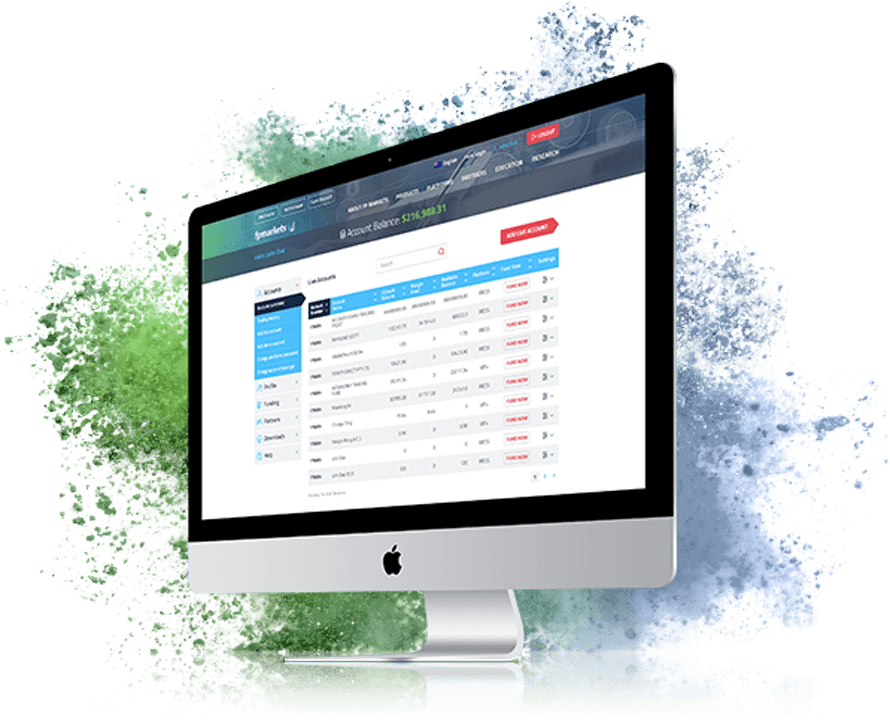MAM Brokers
MAM brokers offer money management services to traders. These can be professional investors or financial advisors that trade on behalf of clients. This is typically a paid-for feature, with money managers normally taking a set percentage of the profits gained. This tutorial will cover the best brokers with MAM trading systems, the differences between a MAM and PAMM account, plus tips for getting started.
How MAM Trading Works
MAM stands for Multi-Account Manager. These solutions essentially allow financial managers to act on behalf of several customers, operating a ‘master account’ from which they can execute trades and manage risk. Customer accounts that are connected to the MAM profile are known as ‘slave accounts’. Importantly, managed accounts are a great opportunity for new traders to benefit from the experience of veteran investors. Clients typically pay a fixed percentage of profits to the fund manager, with rates varying between providers.
To get started you will need to open a managed trading account at a supporting broker. At the sign-up stage, you will be asked to declare your risk appetite and maximum investment amount. The MAM fund manager will then use their ‘master account’ to open and close trades for you. This action will be reflected across all connected customer profiles.
There may be some variation in how trades are executed within the pool of accounts depending on your individual trading requirements. Still, fund managers have the power to invest your capital and you won’t be consulted before positions are opened or closed. With that said, the top MAM brokers do offer real-time performance reporting.

Note, even professionals cannot guarantee profits – these systems are not get rich quick schemes.
Alternative Managed Accounts
An increasing number of aspiring traders are looking for a hands-off approach to investing. One way brokers are catering to this demand is through the managed account concept. But as well as MAM accounts, some brands also offer PAMM solutions and copy trading services. Below we break down the key differences:
- PAMM – Percentage Allocation Money Management (PAMM) is probably the most popular managed account system. This automated trading account pools money which is then used for trading forex, stocks and other popular markets. Similar to MAM trading, there is minimum investor involvement. Fund managers use the pooled money to trade per his/her strategy and style. Importantly, clients can assign portions of their capital to various money managers.
- Social/copy trading – Copy trading lets users mirror the positions of experienced investors. Also known as social trading, platforms often encourage an interactive network and community where traders can exchange strategy tips and market insights. Social trading solutions essentially help traders interact with each other – observing peers’ trades and learning about their decision-making process. Brokers also often operate a ‘leaderboard’ to help you choose the best master traders based on their track record.
Are MAM Accounts Safe?
There is no guarantee of profits with MAM trading systems. Having said that, they do connect beginners with established investors who understand and have experience in the financial markets. Still, we always recommend signing up with regulated MAM brokers, such as Axi, Pepperstone and AvaTrade. These trusted brands provide an additional layer of security and fund protection. Clients can also choose their preferred investing conditions, including maximum risk exposure and trading markets.
In addition, the top MAM brokers provide a transparent service and offer some degree of control to users. For example, the best companies do not impose arduous restrictions on the minimum time capital must be invested for while offering get-out clauses if you are not comfortable with the performance or trading behavior of your money manager. Real-time performance metrics and a breakdown of previous trading history should also be offered to help you find a suitable money manager.
Note, clients are usually required to complete a Power of Attorney and fee disclosure form before opening an account.
Comparing MAM Brokers
There are several factors to compare when choosing between MAM brokers and accounts:
- Transparency – Look for brokers that provide access to real-time performance reporting. The top brands also display profit and loss over fixed intervals.
- Platform & tools – You should be able to manage your account and track progress on popular platforms like MetaTrader 4 (MT4). Some providers also offer proprietary platforms or bespoke software. Importantly, we recommend looking for tools and analysis features that are intuitive and user-friendly.
- Access to assets – The best MAM accounts offer trading opportunities on various markets from forex and stocks to precious metals and cryptocurrencies. This can help build a diverse portfolio and spread risk.
- Safety & regulation – Open a MAM account with a regulated broker for additional security. Licensed brands typically segregate client funds, offer negative balance protection and vet prospective fund managers.
- Fees – Ensure you understand the cut of profits your fund manager and broker will take before opening an account. These charges usually come in the form of a percentage-based performance fee and/or an ongoing management fee. Importantly, charges vary between MAM brokers but can be around 10% of profits. Some brokers also take a commission on every trade. In addition, deposit and withdrawal charges may apply.

Pros of MAM Brokers
- Portfolio diversification – Using a money manager is a great way to invest your capital across various asset classes. The top fund managers have the skills to enter trades in complex instruments which may not be suitable for new or novice traders.
- Time management – Using a MAM account offers a hands-off approach to trading meaning you don’t need to spend hours selecting and monitoring positions. This makes it ideal for those with less time.
- Trading experience – A managed account does most of the hard work for you, meaning you don’t need to be an expert in the forex markets, for example. There are no requirements to research assets or find the best trading opportunities as this is part of the service.
Cons of MAM Brokers
- Benefits for large accounts – Slave accounts with the greatest balance under the control of the money manager may be favored. Accounts with the smallest holdings may not always be allocated a share of minor positions.
- Risk – Although managed accounts are serviced by ‘professionals’, there is still a level of risk involved. Having no input into the positions opened and closed by the MAM account holder can be unsettling. And importantly, profits are not guaranteed.
- Fees – Charges apply with MAM brokers and accounts. Traders must pay the fund manager a fee based on performance while the broker will also take a cut. Avoid firms and websites with an unclear pricing schedule and hidden charges.
- Reliance on services – It can feel convenient and relaxing to let someone else execute trades for you. However, it does take away the fun and experience of learning how to invest yourself. Today, the best retail brokers offer detailed educational tools and content so even inexperienced traders can have a go at making money.
Bottom Line on MAM Brokers
MAM trading can offer an excellent, effectively automated service. It can be particularly helpful for new investors and those looking for a hands-off approach to trading. MAM accounts are also a great way to diversify your trading portfolio. But importantly, be clear on your risk appetite, investing timeframe and trading goals upfront. Also register with a regulated brand and research individual money managers before committing personal capital.
FAQ
What Is A MAM Account?
A MAM account is a multi-account managed service. It is a software solution that allows a single money manager to control more than one client trading account at the same time.
Do I Have To Pay To Use A MAM Account?
Traders usually have to pay the fund manager a fee based on performance. This is often a percentage of any profits. It is also worth getting clear on any upfront and ongoing maintenance and account charges before signing up with a broker.
What Are The Best MAM Account Brokers?
There is no ‘best’ MAM broker as traders have different requirements and goals. With that said, things to consider include the fee structure, trading platform, regulatory status and the fund manager’s previous trading history. Also make sure the MAM broker takes into account your personal preferences, such as risk appetite and investment objectives.
What Is The Difference Between A MAM And PAMM Account?
MAM stands for Multi-Account Manager while PAMM stands for Percentage Allocation Management Module. MAM accounts let money managers apply a similar percentage-based system, however, PAMM accounts offer greater flexibility to diversify trades and amend risk exposure between sub-accounts. Note, both MAM/PAMM accounts are suitable for those looking for hands-off trading systems.
